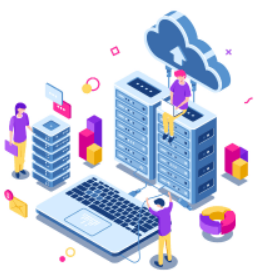As digital transformation accelerates, businesses and developers are exploring advanced computing models that provide better performance, lower latency, and improved data control. Two prominent paradigms shaping today’s IT landscape are edge computing and cloud computing. While they both serve to process and store data, their approaches, use cases, and benefits differ significantly. In this blog post, we’ll explore the core differences between edge and cloud computing, outline real-world applications, and show how they fit within the context of cloud hosting, web hosting providers, and modern infrastructure trends.
What is Cloud Computing?
Cloud computing is a model in which computing resources—like storage, processing power, and applications—are delivered over the internet. Services such as Amazon Web Services (AWS), Microsoft Azure, and Google Cloud allow businesses to rent infrastructure and scale on demand.
Key Characteristics of Cloud Computing:
-Centralized data centers
-Pay-as-you-go pricing
-Virtually unlimited scalability
-Access from any internet-connected device
Common Uses:
-Hosting websites and applications
-Running enterprise software (ERP, CRM)
-Big data analysis
-Data backup and recovery
Cloud hosting is a popular solution among businesses seeking scalability and cost-efficiency. A web hosting provider offering cloud services typically ensures high availability, distributed architecture, and optimized server performance.
What is Edge Computing?
Edge computing is a decentralized approach that brings computation and data storage closer to the location where it’s needed, reducing latency and bandwidth use. Instead of sending all data to a centralized cloud server, edge computing processes it locally—on or near the device collecting the data.
Key Characteristics of Edge Computing:
-Localized data processing
-Near real-time response
-Reduces reliance on internet connectivity
-Ideal for IoT and remote environments
Common Uses:
-Smart cities aynd autonomous vehicles
-Industrial IoT (IIoT)
-Augmented and virtual reality (AR/VR)
-Video surveillance and analytics
Edge computing excels in scenarios where speed and minimal latency are essential, and is becoming a strategic complement to traditional cloud hosting models.
Key Differences Between Edge and Cloud Computing
| Feature | Cloud Computing | Edge Computing |
|---|---|---|
| Architecture | Centralized | Decentralized |
| Latency | Higher (depends on internet speed) | Low (local processing) |
| Scalability | Virtually unlimited | Limited to local hardware |
| Data Processing | Remote data centers | At or near the data source |
| Ideal Use Cases | Web apps, enterprise software | IoT, real-time analytics |
| Internet Dependency | High | Low to moderate |
| Maintenance | Managed by cloud provider | On-site or localized infrastructure |
How They Work Together
Rather than replacing each other, edge computing and cloud computing often work in tandem. In a hybrid approach, edge devices handle immediate processing needs, while the cloud stores long-term data, provides backups, and runs intensive applications.
Example: A smart factory might use edge computing to monitor equipment in real time, but rely on cloud computing for trend analysis, historical data storage, and system-wide reporting.
Impact on Web Hosting Providers
Modern web hosting providers are evolving to support edge capabilities alongside their cloud hosting infrastructure. Companies like Cloudflare, Fastly, and Amazon are building edge networks that bring content closer to users, boosting performance.
Benefits of Edge-Enhanced Hosting:
-Faster content delivery through edge servers (CDNs)
-Improved site performance and SEO
-Reduced latency for international users
The best web hosting services now include integrated content delivery networks (CDNs), edge functions, and serverless environments that cater to high-performance demands.
Choosing Between Edge and Cloud
Your choice depends on the nature of your business and technical requirements:
Choose Cloud Computing If:
-You need scalability and centralized management
-Your app or website can tolerate some latency
-You prefer managed infrastructure
Choose Edge Computing If:
-Real-time performance is critical
-Devices must function with limited connectivity
-You manage large-scale IoT or remote systems
For many businesses, a hybrid approach that uses both edge and cloud delivers the best of both worlds. This strategy leverages the flexibility and power of the cloud with the speed and precision of edge processing.
Future Trends
As 5G networks, AI, and IoT continue to evolve, the demand for edge computing will rise. However, cloud computing remains the backbone of most digital services.
Emerging Innovations Include:
-AI at the edge for autonomous decision-making
-Serverless edge functions
-Enhanced security at edge nodes
-Federated learning using cloud-edge synergy
Web hosting providers will increasingly offer products that blend edge capabilities into traditional cloud hosting environments, making these services accessible even to smaller businesses.
Final Thoughts
While cloud computing provides powerful, centralized solutions for scalability and data management, edge computing offers a decentralized alternative ideal for real-time and remote applications. Understanding the strengths and limitations of each allows businesses to architect smarter, more efficient systems.
Whether you’re launching a website, managing a fleet of IoT devices, or optimizing enterprise performance, your choice between edge and cloud—or a combination of both—should be guided by specific needs, goals, and user expectations.
To make the most of this evolving landscape, partner with a forward-thinking web hosting provider that supports both cloud and edge infrastructure. The best web hosting services will provide flexibility, reliability, and cutting-edge performance to help your business thrive in a fast-paced digital world.

